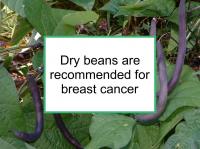A variety of dry beans (Phaseolus vulgaris) are available in the U.S. For purposes of this website, dry beans include black beans, kidney beans, navy beans, pinto beans, pink beans, red beans and white beans. Dark colored beans generally have superior chemopreventative properties compared to white or light colored beans.
The following beans are covered in other webpages: adzuki beans, chickpeas, lentils, lima beans, and mung beans. This website does not specifically cover black-eyed peas or fava beans, for which not enough data is available.
Dry beans are dietary sources of the lignan enterolactone, as well as choline, coumestrol, copper, folate and lupeol. Black beans also incorporate significant levels of anthocyanins such as cyanidin-3-glucoside and malvidin. White beans are a better source of iron than red beans.
Breast cancer-related effects of eating dry beans
Epidemiological evidence suggests beans inhibit breast cancer
Dry beans have been linked to reduced breast cancer risk and improved survival. For example, a study of the diets of 90,630 women in the Nurses Health Study II found a significant inverse relationship between breast cancer risk and bean intake. Another study reported that women with high dry bean intake were significantly less likely to develop breast cancer, especially hormone receptor negative (ER-/PR-) breast cancer. Yet another study reported that higher intake of dry beans improved survival among postmenopausal women with breast cancer.
Postmenopausal women with breast cancer and a high intake of enterolactone have been found to be less likely to die from their breast cancer than those with a low intake. Enterolactone has also been found to increase the sensitivity of breast cancer cells to radiation, thereby potentially enhancing the treatment effects of radiotherapy.
Animal studies also demonstrate beans inhibit breast cancer
Several studies have found that dry bean consumption reduces mammary tumor incidence in rats. One study that examined the cellular processes by which tumor burden was reduced reported that the dominant process was induction of apoptosis (programmed cell death). Circuling insulin and insulin-like growth factor-1 (both risk factors for breast cancer) were also reduced.
Black beans have greater chemopreventive properties
Black beans incorporate anthocyanins and other phenolic compounds that are associated with reduced breast cancer risk. One study found six flavonoids in the coats of black beans with potent antiproliferative activities against hormone receptor positive (ER+/PR+) breast cancer cells. Another study found that tanins isolated from black beans inhibited angiogenesis, the growth of new blood vessels.
Dry beans incorporate copper
Dry beans should be consumed in moderation since they contain some copper (up to 0.2 mg per ounce), which could contribute to angiogenesis and metastasis, especially in aggressive forms of breast cancer such as inflammatory (IBC), triple negative (ER-/PR-/HER2-), and HER2 overexpressing (HER2+) disease. While copper is a vital nutrient, women with breast cancer who are not anemic probably should not exceed the RDA (recommended daily allowance) of approximately 0.9 mg.
Sources of information provided in this webpage
The information above, which is updated continually as new research becomes available, has been developed based solely on the results of academic studies. Clicking on any of the underlined terms will take you to its tag or webpage, which contain more extensive information.
Below are links to 20 recent studies concerning this food and its components. For a more complete list, including less recent studies, please click on dry beans.
